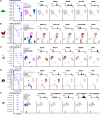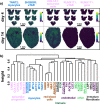Uncovering transcriptional dark matter via gene annotation independent single-cell RNA sequencing analysis
- PMID: 33846360
- PMCID: PMC8042062
- DOI: 10.1038/s41467-021-22496-3
Uncovering transcriptional dark matter via gene annotation independent single-cell RNA sequencing analysis
Abstract
Conventional scRNA-seq expression analyses rely on the availability of a high quality genome annotation. Yet, as we show here with scRNA-seq experiments and analyses spanning human, mouse, chicken, mole rat, lemur and sea urchin, genome annotations are often incomplete, in particular for organisms that are not routinely studied. To overcome this hurdle, we created a scRNA-seq analysis routine that recovers biologically relevant transcriptional activity beyond the scope of the best available genome annotation by performing scRNA-seq analysis on any region in the genome for which transcriptional products are detected. Our tool generates a single-cell expression matrix for all transcriptionally active regions (TARs), performs single-cell TAR expression analysis to identify biologically significant TARs, and then annotates TARs using gene homology analysis. This procedure uses single-cell expression analyses as a filter to direct annotation efforts to biologically significant transcripts and thereby uncovers biology to which scRNA-seq would otherwise be in the dark.
Conflict of interest statement
The authors declare no competing interests.
Figures




Similar articles
-
Genome annotation with long RNA reads reveals new patterns of gene expression and improves single-cell analyses in an ant brain.BMC Biol. 2021 Nov 27;19(1):254. doi: 10.1186/s12915-021-01188-w. BMC Biol. 2021. PMID: 34838024 Free PMC article.
-
Necklace: combining reference and assembled transcriptomes for more comprehensive RNA-Seq analysis.Gigascience. 2018 May 1;7(5):giy045. doi: 10.1093/gigascience/giy045. Gigascience. 2018. PMID: 29722876 Free PMC article.
-
scAPAtrap: identification and quantification of alternative polyadenylation sites from single-cell RNA-seq data.Brief Bioinform. 2021 Jul 20;22(4):bbaa273. doi: 10.1093/bib/bbaa273. Brief Bioinform. 2021. PMID: 33142319
-
Critical downstream analysis steps for single-cell RNA sequencing data.Brief Bioinform. 2021 Sep 2;22(5):bbab105. doi: 10.1093/bib/bbab105. Brief Bioinform. 2021. PMID: 33822873 Review.
-
Single-cell RNA sequencing in breast cancer: Understanding tumor heterogeneity and paving roads to individualized therapy.Cancer Commun (Lond). 2020 Aug;40(8):329-344. doi: 10.1002/cac2.12078. Epub 2020 Jul 12. Cancer Commun (Lond). 2020. PMID: 32654419 Free PMC article. Review.
Cited by
-
Mouse lemur cell atlas informs primate genes, physiology and disease.Nature. 2025 Aug;644(8075):185-196. doi: 10.1038/s41586-025-09114-8. Epub 2025 Jul 30. Nature. 2025. PMID: 40739355 Free PMC article.
-
An organism-wide atlas of hormonal signaling based on the mouse lemur single-cell transcriptome.Nat Commun. 2024 Mar 11;15(1):2188. doi: 10.1038/s41467-024-46070-9. Nat Commun. 2024. PMID: 38467625 Free PMC article.
-
Deep sequencing unveils altered cardiac miRNome in congenital heart disease.Mol Genet Genomics. 2022 Jul;297(4):1123-1139. doi: 10.1007/s00438-022-01908-z. Epub 2022 Jun 7. Mol Genet Genomics. 2022. PMID: 35668131
-
Single-cell RNA-seq reveals distinct metabolic "microniches" and close host-symbiont interactions in deep-sea chemosynthetic tubeworm.Sci Adv. 2024 Jul 26;10(30):eadn3053. doi: 10.1126/sciadv.adn3053. Epub 2024 Jul 24. Sci Adv. 2024. PMID: 39047091 Free PMC article.
-
Spatial mapping of the total transcriptome by in situ polyadenylation.Nat Biotechnol. 2023 Apr;41(4):513-520. doi: 10.1038/s41587-022-01517-6. Epub 2022 Nov 3. Nat Biotechnol. 2023. PMID: 36329320 Free PMC article.
References
Publication types
MeSH terms
Substances
Grants and funding
LinkOut - more resources
Full Text Sources
Other Literature Sources
Molecular Biology Databases
Miscellaneous

